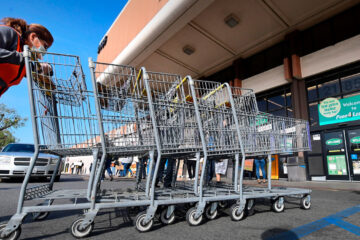Amazon, the largest online retailer in the world, is preparing to feel the brunt of President Donald Trump’s tariffs.
Tariffs are taxes companies pay to import goods from overseas, and the extra cost is often passed down to consumers through price increases.
💵💰Don’t miss the move: Subscribe to TheStreet’s free daily newsletter 💰💵
On April 2, Trump announced a 10% “baseline” tariff on all countries importing goods to the U.S., with roughly 60 countries seeing higher tariff rates, in an effort to free the nation from its reliance on imported goods.
Related: Amazon CEO gives hard-nosed message to employees
However, on April 9, Trump switched gears and increased his previous reciprocal 34% tariff on China to 125%. Including all tariffs, taxes on imported goods from China now stands at 145%. He also paused reciprocal tariffs on all other countries for 90 days, bringing them down to a universal rate of 10%.
Many consumers across the country plan to cut back on their spending to prepare for higher prices due to Trump’s tariffs.
According to a recent Market Pulse survey from InMoment, 60% of consumers said they plan to shop less rather than more in preparation for potential price hikes from tariffs, which could decrease many retailers’ sales.
Amazon parcels are prepared for delivery at Amazon’s Robotic Fulfillment Centre in Sutton Coldfield, England.
Nathan Stirk/Getty Images
Amazon makes a major change amid tariff concerns
Amid this growing threat, Amazon has decided to cancel orders for products made in China and other Asian countries, according to a recent report from Bloomberg.
Amazon’s decision occurred shortly after Trump’s tariff announcement on April 2. The retailer canceled orders for items such as scooters, beach chairs, air conditioners, etc.
One vendor that Amazon works with told Bloomberg that the retailer sent them an email last week stating that it was canceling a $500,000 wholesale order placed “in error.”
Related: Mark Cuban sounds alarm on how consumers should handle tariffs
The vendor was selling beach chairs made in China, and the cancelation forced them to pay the factory and look for other buyers since the chairs had already been manufactured.
An e-commerce consultant also told Bloomberg that Amazon has been canceling orders for products made in China and other Asian countries from several clients without notice.
According to a survey conducted by Jungle Scout, roughly 70% of the products sold on Amazon by wholesalers and retailers are sourced from China. So, it is no surprise that Amazon may be making these drastic changes to dodge the high costs associated with Trump’s tariffs on China.
Amazon CEO addresses growing threat of tariffs
During a recent interview with CNBC, Amazon CEO Andy Jassy responded to recent reports that the company was cutting back on purchases from China by highlighting that the main goal is to keep prices low for consumers.
More Retail:
AT&T quietly issues stern warning to customers Sam’s Club makes a big change to a beloved membership perkGameStop announces risky move amid store closures
“Whenever you have any threat of any kind of discontinuity, as a team, you have to think about what are the things you can do to help customers,” said Jassy. “So we’re doing everything we can to try and keep prices the way they’ve been for customers – as low as possible. We’ve done some strategic forward inventory buys to get as many items as makes sense for customers at lower prices.”
He also said that the company has renegotiated deals with suppliers in some cases to keep prices low for customers. However, Jassy warned that third-party sellers on Amazon may pass extra costs onto consumers due to tariffs.
“I’m guessing that sellers will pass that cost on, I think they’ll try, and I understand why,” said Jassy. “I mean, depending on which country you’re in, you don’t have 50% extra margin that you can play with. So I think they’ll try and pass the cost on. And you know, as I said, it’s so early right now, but we haven’t seen any change in consumer behavior in a meaningful way yet.”
Related: Veteran fund manager unveils eye-popping S&P 500 forecast


